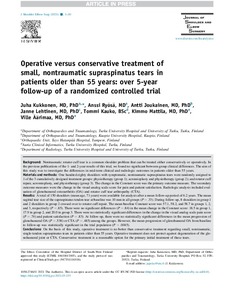Operative versus conservative treatment of small, nontraumatic supraspinatus tears in patients older than 55 years: over 5-year follow-up of a randomized controlled trial
Kukkonen Juha; Ryösä Anssi; Joukainen Antti; Lehtinen Janne; Kauko Tommi; Mattila Kimmo; Äärimaa Ville
https://urn.fi/URN:NBN:fi-fe2021093048338
Tiivistelmä
Background
Nontraumatic rotator cuff tear is a common shoulder problem that can be treated either conservatively or operatively. In the previous publications of the 1- and 2-year results of this trial, we found no significant between-group clinical differences. The aim of this study was to investigate the differences in mid-term clinical and radiologic outcomes in patients older than 55 years.
Materials and methods
One hundred eighty shoulders with symptomatic, nontraumatic supraspinatus tears were randomly assigned to 1 of the 3 cumulatively designed treatment groups: physiotherapy (group 1); acromioplasty and physiotherapy (group 2); and rotator cuff repair, acromioplasty, and physiotherapy (group 3). The change in the Constant score was the primary outcome measure. The secondary outcome measures were the change in the visual analog scale score for pain and patient satisfaction. Radiologic analysis included evaluation of glenohumeral osteoarthritis (OA) and rotator cuff tear arthropathy (CTA).
Results
A total of 150 shoulders (mean age, 71 years) were available for analysis after a mean follow-up period of 6.2 years. The mean sagittal tear size of the supraspinatus tendon tear at baseline was 10 mm in all groups (P = .33). During follow-up, 8 shoulders in group 1 and 2 shoulders in group 2 crossed over to rotator cuff repair. The mean baseline Constant score was 57.1, 58.2, and 58.7 in groups 1, 2, and 3, respectively (P = .85). There were no significant differences (P = .84) in the mean change in the Constant score: 18.5 in group 1, 17.9 in group 2, and 20.0 in group 3. There were no statistically significant differences in the change in the visual analog scale pain score (P = .74) and patient satisfaction (P = .83). At follow-up, there were no statistically significant differences in the mean progression of glenohumeral OA (P = .538) or CTA (P = .485) among the groups. However, the mean progression of glenohumeral OA from baseline to follow-up was statistically significant in the trial population (P = .0045).
Conclusions
On the basis of this study, operative treatment is no better than conservative treatment regarding small, nontraumatic, single-tendon supraspinatus tears in patients older than 55 years. Operative treatment does not protect against degeneration of the glenohumeral joint or CTA. Conservative treatment is a reasonable option for the primary initial treatment of these tears.
Level of evidence
Keywords
Kokoelmat
- Rinnakkaistallenteet [27094]
